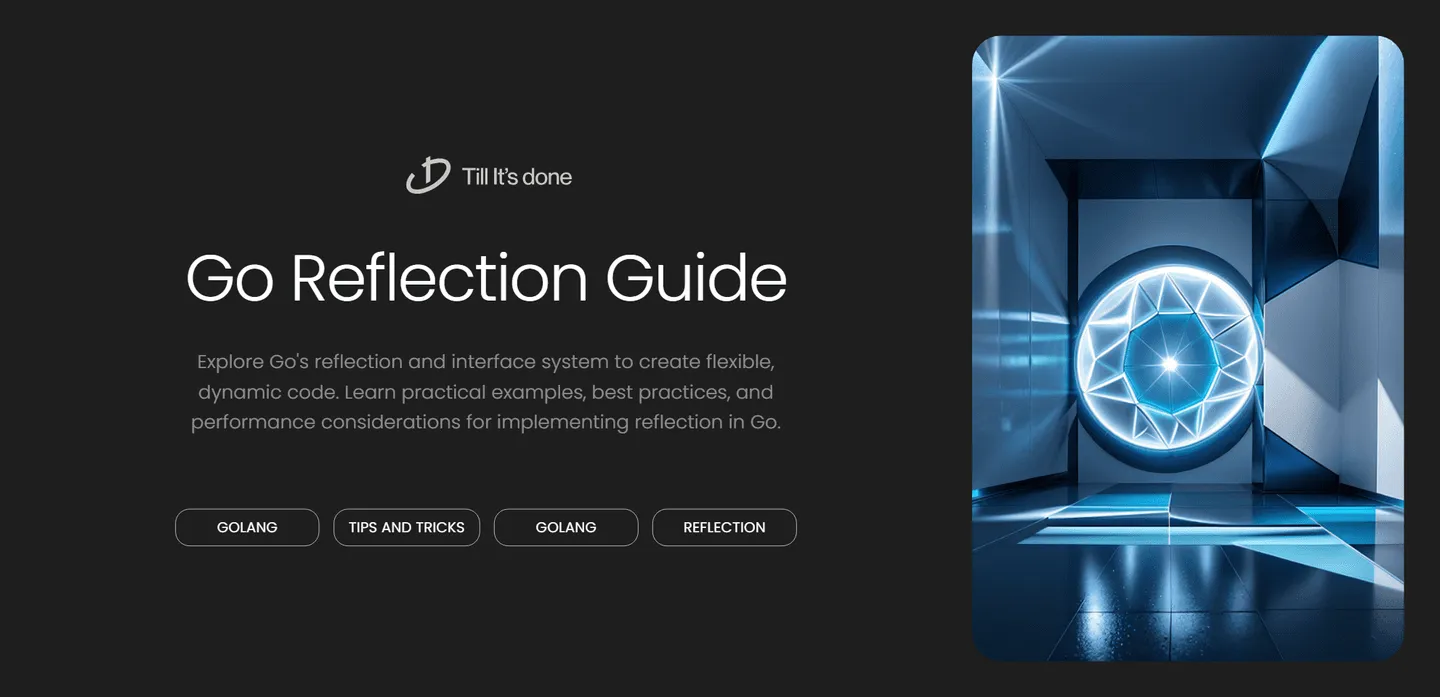- Services
- Case Studies
- Technologies
- NextJs development
- Flutter development
- NodeJs development
- ReactJs development
- About
- Contact
- Tools
- Blogs
- FAQ
Advanced Go: Working with Reflection & Interfaces
Learn practical examples, best practices, and performance considerations for implementing reflection in Go.

Advanced Go: Working with Reflection and Interfaces

Go’s reflection and interface system provides powerful tools for creating flexible and dynamic code. In this deep dive, we’ll explore advanced techniques for working with reflection and interfaces that can elevate your Go programming skills to the next level.
Understanding Go’s Reflection Package
At its core, reflection allows programs to examine, modify, and create variables, functions, and types at runtime. While it should be used judiciously, reflection opens up possibilities for creating more generic and adaptable code.
Let’s start with a practical example that demonstrates the power of reflection:
type Customer struct { Name string Age int Address string}
func inspectStruct(v interface{}) { val := reflect.ValueOf(v) typ := val.Type()
fmt.Printf("Type: %v\n", typ) for i := 0; i < val.NumField(); i++ { field := typ.Field(i) value := val.Field(i) fmt.Printf("Field: %s\tType: %v\tValue: %v\n", field.Name, field.Type, value) }}
Working with Interface Types
Interfaces in Go provide a powerful way to define behavior and create abstraction. When combined with reflection, they become even more versatile. Here’s how we can use reflection to work with interfaces dynamically:
type Processor interface { Process(data string) string}
func callProcess(v interface{}) { // Check if v implements Processor typ := reflect.TypeOf((*Processor)(nil)).Elem() val := reflect.ValueOf(v)
if val.Type().Implements(typ) { result := val.MethodByName("Process").Call([]reflect.Value{ reflect.ValueOf("test data"), }) fmt.Println("Process result:", result[0].String()) }}Advanced Reflection Patterns
One powerful application of reflection is creating generic data validators or mappers. Here’s an example of a function that can validate struct fields based on tags:
type User struct { Name string `validate:"required,min=3"` Email string `validate:"required,email"` Age int `validate:"required,min=18"`}
func validateStruct(v interface{}) []string { var errors []string val := reflect.ValueOf(v) typ := val.Type()
for i := 0; i < val.NumField(); i++ { field := typ.Field(i) value := val.Field(i)
if validateTag := field.Tag.Get("validate"); validateTag != "" { rules := strings.Split(validateTag, ",") for _, rule := range rules { if err := validateField(field.Name, value, rule); err != nil { errors = append(errors, err.Error()) } } } } return errors}
Performance Considerations
While reflection is powerful, it comes with performance overhead. Here are some tips for using reflection efficiently:
- Cache reflect.Type information when possible
- Avoid reflection in hot paths
- Use interface assertions when type information is known
- Consider code generation alternatives for critical paths
Best Practices and Common Pitfalls
When working with reflection and interfaces, keep these guidelines in mind:
- Use reflection only when simpler alternatives don’t exist
- Always validate interface implementations at runtime
- Handle nil pointer cases carefully
- Test edge cases thoroughly
- Document why reflection is necessary
Remember that while reflection is powerful, it should be used sparingly and thoughtfully in your Go code.

 สร้างเว็บไซต์ 1 เว็บ ต้องใช้งบเท่าไหร่? เจาะลึกทุกองค์ประกอบ website development cost อยากสร้างเว็บไซต์แต่ไม่มั่นใจในเรื่องของงบประมาณ อ่านสรุปเจาะลึกตั้งแต่ดีไซน์, ฟังก์ชัน และการดูแล พร้อมตัวอย่างงบจริงจาก Till it’s done ที่แผนชัด งบไม่บานปลายแน่นอน
สร้างเว็บไซต์ 1 เว็บ ต้องใช้งบเท่าไหร่? เจาะลึกทุกองค์ประกอบ website development cost อยากสร้างเว็บไซต์แต่ไม่มั่นใจในเรื่องของงบประมาณ อ่านสรุปเจาะลึกตั้งแต่ดีไซน์, ฟังก์ชัน และการดูแล พร้อมตัวอย่างงบจริงจาก Till it’s done ที่แผนชัด งบไม่บานปลายแน่นอน  Next.js สอน 14 ขั้นตอนเบื้องต้น: สร้างโปรเจกต์แรกใน 30 นาที เริ่มต้นกับ Next.js ใน 14 ขั้นตอนเพียงแค่ 30 นาที พร้อม SSR/SSG และ API Routes ด้วยตัวอย่างโค้ดง่าย ๆ อ่านต่อเพื่อสร้างโปรเจ็กต์แรกได้ทันทีที่นี่
Next.js สอน 14 ขั้นตอนเบื้องต้น: สร้างโปรเจกต์แรกใน 30 นาที เริ่มต้นกับ Next.js ใน 14 ขั้นตอนเพียงแค่ 30 นาที พร้อม SSR/SSG และ API Routes ด้วยตัวอย่างโค้ดง่าย ๆ อ่านต่อเพื่อสร้างโปรเจ็กต์แรกได้ทันทีที่นี่  วิธีสมัคร Apple Developer Account เพื่อนำแอปขึ้น App Store ทีละขั้นตอน อยากปล่อยแอปบน App Store ระดับโลก มาอ่านคู่มือสมัคร Apple Developer Account พร้อมเคล็ดลับ TestFlight และวิธีอัปโหลดที่ง่ายในบทความเดียวนี้ได้เลย
วิธีสมัคร Apple Developer Account เพื่อนำแอปขึ้น App Store ทีละขั้นตอน อยากปล่อยแอปบน App Store ระดับโลก มาอ่านคู่มือสมัคร Apple Developer Account พร้อมเคล็ดลับ TestFlight และวิธีอัปโหลดที่ง่ายในบทความเดียวนี้ได้เลย  TypeScript Interface คืออะไร? อธิบายพร้อมวิธีใช้และข้อแตกต่างจาก Type เรียนรู้วิธีใช้ TypeScript Interface เพื่อสร้างโครงสร้างข้อมูลที่ปลอดภัยและเข้าใจง่าย พร้อมเปรียบเทียบข้อดีข้อแตกต่างกับ Type ที่คุณต้องรู้ ถูกรวมเอาไว้ในบทความนี้แล้ว
TypeScript Interface คืออะไร? อธิบายพร้อมวิธีใช้และข้อแตกต่างจาก Type เรียนรู้วิธีใช้ TypeScript Interface เพื่อสร้างโครงสร้างข้อมูลที่ปลอดภัยและเข้าใจง่าย พร้อมเปรียบเทียบข้อดีข้อแตกต่างกับ Type ที่คุณต้องรู้ ถูกรวมเอาไว้ในบทความนี้แล้ว  Material-UI (MUI) คืออะไร อยากสร้าง UI สวยงามและเป็นมืออาชีพในเวลาอันรวดเร็วใช่ไหม มาทำความรู้จักกับ Material-UI (MUI) ที่ช่วยให้คุณพัฒนาแอปพลิเคชันบน React ได้ง่ายและดูดีในทุกอุปกรณ์
Material-UI (MUI) คืออะไร อยากสร้าง UI สวยงามและเป็นมืออาชีพในเวลาอันรวดเร็วใช่ไหม มาทำความรู้จักกับ Material-UI (MUI) ที่ช่วยให้คุณพัฒนาแอปพลิเคชันบน React ได้ง่ายและดูดีในทุกอุปกรณ์  เปรียบเทียบ 3 วิธีติดตั้ง install node js บน Ubuntu: NVM vs NodeSource vs Official Repo แบบไหนดีที่สุด? เรียนรู้วิธีติดตั้ง Node.js บน Ubuntu ด้วย NVM, NodeSource หรือ Official Repo เลือกวิธีที่เหมาะกับความต้องการของคุณ พร้อมเปรียบเทียบ เพื่อการพัฒนาที่มีประสิทธิภาพ!
เปรียบเทียบ 3 วิธีติดตั้ง install node js บน Ubuntu: NVM vs NodeSource vs Official Repo แบบไหนดีที่สุด? เรียนรู้วิธีติดตั้ง Node.js บน Ubuntu ด้วย NVM, NodeSource หรือ Official Repo เลือกวิธีที่เหมาะกับความต้องการของคุณ พร้อมเปรียบเทียบ เพื่อการพัฒนาที่มีประสิทธิภาพ! พูดคุยกับซีอีโอ
We'll be right here with you every step of the way.
We'll be here, prepared to commence this promising collaboration.
Whether you're curious about features, warranties, or shopping policies, we provide comprehensive answers to assist you.


